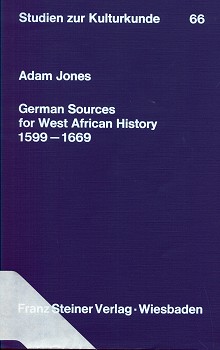
ulsheimer : canoes and whaling, west africa, 1600.
| home | catalogue | history | references | appendix |
 |
surfresearch.com.au
ulsheimer : canoes and whaling, west africa, 1600. |
Published in
Jones., Adam:
German Sources
for West Afican History 1599-1699.
FranzSteijnerVerlang,
Wiesbaden, 1983
Studien zur Kulturkunde
66
Canoes
Ulsheimer records
his ship being approached by sixty canoes, apparently intending to attack.
Upon firing canon
at close range, the natives initial response was to dive underwater, then
retreat in their canoes.
The following day,
two canoes appeared with caution, one natve "repeatedly dipping a finger
in the water and holding this wet finger over their right eye,"
Indicating "do you
come in peace and to trade?", Adam Jones (1983) notes that this was a standard
sign along the Ivory Coast and at Cape Three Points, and lists several
similar reports from 1663 to 1735.
This is said to
take place off the coast of Cameroon, however, Jones suggests that
Ulsheimer may have confused his memories of the Ivory Coast with those
of Cameroon.
Whaling
At Cape Verde, at
the beginning of the coast of Guinea, Ulsheimer finds nothing of value
to trade, except for ambergris.
Of this, he is skeptical
of its value, "a great swindle," and of its provinance, writing that it
"is supposed to come from a whale."
Ambergris was highly
valued for use in perfumes and cooking, and is, indeed, a very rare product
of from whales.
This strongly suggests
that the ambergris was procured by local fisherman regularly hunting whales
off-shore.
The Author
Born in Germany
in 1578, Andreas Joshua Ulsheimer (or Ultzheimer) trained in as a surgeon,
in which role (and barber) he travelled the world from 1596 to 1609,
including a visit to West Africa in 1603-1604.
The Book
A draft account
of Ulsheimer's journal was rewritten by a clerk, under his supervision,
and completed in 1616, but not published.
Sections of a brother's
copy, made in 1622, on America and Africa were published by Crecelius in
1878-1879.
The original manuscript
disappeared in 1945, however a photocopy held by Wilhelm Schneider of Tlibingen
was used to prepare a translation of the comple work by Werg, published
in 1971.
Considering Werg's
edition as "not very reliable," this new translation of the African section
by Adam Jones was prepared from the photocopy.
In his introduction,
Jones notes:
"Ulsheimer's ethnographic
observations on 'Guinea' (principally Cape Coast and Accra) and Benin complement
the work of De Marees, who visited Africa a year earlier.
De Marees's book
deals mainly with the Gold Coast."
He also notes:
"I have renumbered the chapters translated here, which are numbered 1, 2, 3, 4, 8 ,9 and 10 in the second part ofUlsheimer's manuscript."
See Jones: Introduction, pages 19 and 20.
Page 25
[f. 33a]
When we first arrived in the Rio de Camerones, the Blacks came towards
us in 60 canoes (these are their ships), intending to attack us.
We therefore
prepared to defend ourselves, hanging canvas and sails around the sloop
as bulwarks, and made ready the cannon. Before firing the cannon, however,
we waited till they had come quite close, so that we could start firing
with a good advantage. Upon this unusual and unexpected fire and thunder,
they were so frightened that all of them plunged under the water in order
to save themselves; but then they jumped into their canoes again and took
to flight, for we shot many of them.
The next day
two canoes came.
The Blacks kept
their distance, repeatedly dipping a finger in the water and holding this
wet finger over [f. 33b] their right eye.(3)
We could not
understand what they meant by it.
(But by this
they wanted to enquire whether we were willing to keep peace and to trade
or not.)
[Footnote] 23.
Other writers described the same practice on the Ivory Coast and at Cape
Three Points: Hakluyt 1965 I: 104; Van den Broecke 1950: 23; Br!sio VIII:
279; Dapper 1676b: 61 = 1670: 429; Hemmersam 1663: 16; Elbee 1671: 366;
Barbot 1688 I: 167; Phillips
I 1732: 197;
Atkins 1735: 73.
One wonders whether
Ulsheimer here confused his memories a of the Ivory Coast with those of
Cameroon.
Page 28
[f. 45b] At Cabo
[Cape] Verde, 140 north of the equator, the coast of Guinea begins.
The inhabitants
are black Moors, with whom there is nothing to
Page 29
trade except
ambergris (a rubbery musk which is supposed to come from a whale), but
it is a great swindle.(35)
[Footnote] 35.
Ambergris was used in perfumery and cookery.
The trade in
ambergris in the vicinity of Cape Verde was mentioned by Van den Broecke
(1950: 8).
 |
Voyage of 1603-1604. Translated and edited by Adam Jones from a photocopy of the original manuscript, held by Wilhelm Schneider, Tlibingen,1983. Published in
|

| home | catalogue | history | references | appendix |